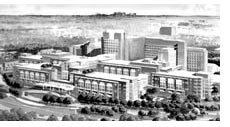 |
||||
|
The Mark O. Hatfield Clinical Research Center will include 248 beds for inpatient and day-hospital care, outpatient facilities, and research laboratories, expanding opportunities for physicians and patients to participate in cutting-edge research and scientific advances. The Clinical Research Center is named in honor of Senator Hatfield of Oregon, who supported medical research throughout his career in Congress, served in the Senate for 30 years and chaired the committee on appropriations for 8 years. The new center will connect to the current Warren G. Magnuson Clinical Center, a 325-bed facility with a 13-story ambulatory care wing. Hallmark of this original building is the proximity of patient care units to scientific labs. The new facility will amplify that tradition, providing a crucial link to rapidly move biomedical findings in the laboratory into the mainstream of medical practice. Outpatient clinics currently housed in the Ambulatory Care Research Facility will remain in the existing building, keeping them adjacent to inpatient units. The building’s design reflects the dual priorities of clinical research and patient care, accommodating the physical requirements of the latest in medical technology while providing the best, most comfortable environment for patients and clinical investigators. Four brick wings, paired around landscaped courtyards, will flank a glass-enclosed science court atrium that will serve as the heart and circulation hub for the new complex. The new three- and four-story wings sweeping across the front of the existing building will allow patients and scientists to take advantage of views to the NIH’s campus setting. Zimmer Gunsul Frasca Partnership, a 260-person architecture, planning, and interior design firm based in Portland, Oregon, won an international competition to design the building. The firm was selected based on flexibility of design, integration of the facility with the campus, and adaptability for the future. Main design considerations include:
|
Clinical Research Center |
|||
 Late in 1997, Vice President Al Gore and Senator Mark O. Hatfield and others broke ground for the new Mark O. Hatfield Clinical Research Center. The CRC center, expected to be complete in 2003, will house new inpatient hospital units, outpatient clinics, day hospitals, and research labs. Together, the Magnuson and Hatfield centers will provide the environment today’s clinical researchers need to advance medical discovery into the future.
Late in 1997, Vice President Al Gore and Senator Mark O. Hatfield and others broke ground for the new Mark O. Hatfield Clinical Research Center. The CRC center, expected to be complete in 2003, will house new inpatient hospital units, outpatient clinics, day hospitals, and research labs. Together, the Magnuson and Hatfield centers will provide the environment today’s clinical researchers need to advance medical discovery into the future.